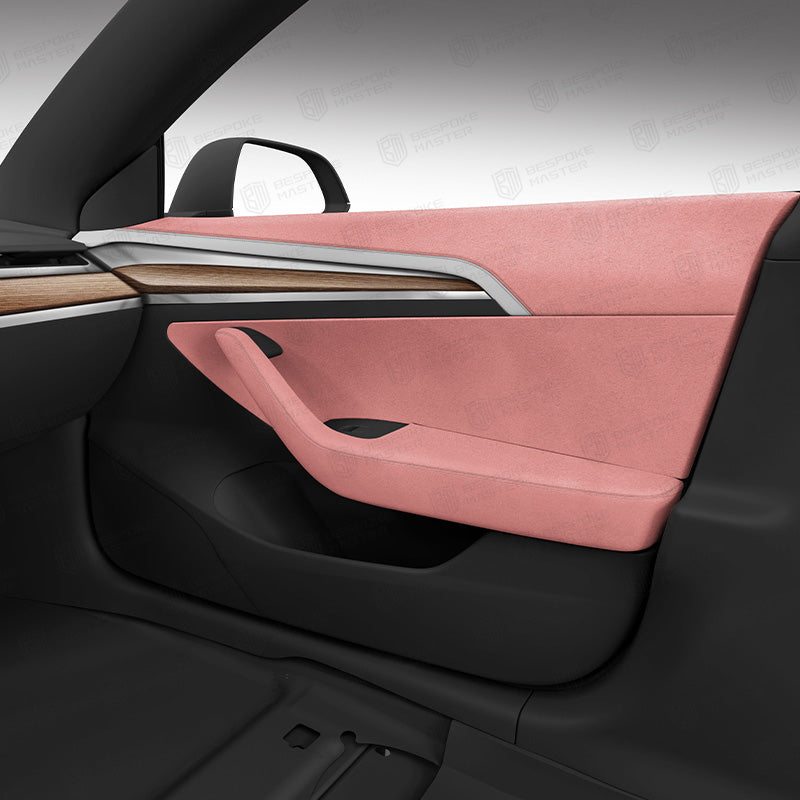
Door Panel Wrapping: Elevate Your Car Interior with a Touch of Luxury
Share
The door panels of a car play a crucial role in both aesthetics and functionality. They not only protect the interior but also significantly impact the overall visual appeal and tactile experience. Custom door panel wrapping can enhance the luxurious feel of your vehicle, improve comfort, and allow for personalized interior styling.
1. Why Should You Wrap Your Car’s Door Panels?
1. Enhance Interior Luxury
High-end cars often come with leather or premium fabric-wrapped door panels, while standard models typically use plastic or basic fabric. Custom wrapping can give even an average car a more luxurious look and feel.
2. Improve Driving Comfort
Soft-touch materials like leather or suede provide a more pleasant surface for resting your arms, reducing discomfort and fatigue on long drives.
3. Reduce Noise and Improve Cabin Insulation
Extra layers of wrapping can help minimize road noise and vibrations, creating a quieter and more comfortable driving experience.
4. Protect Original Door Panels and Extend Lifespan
Over time, factory door panels can develop scratches, discoloration, or wear. Wrapping them not only preserves the original material but also prevents stains and makes cleaning easier.
5. Personalization and Unique Interior Styling
You can choose from various colors and materials to match the seats, dashboard, and steering wheel, giving your car a unique, customized interior.
2. Common Material Options for Door Panel Wrapping
| Material | Features | Suitable For |
|---|---|---|
| Genuine Leather | Premium feel, durable, easy to clean | Car owners seeking high-end luxury and durability |
| Microfiber Leather | Leather-like texture, eco-friendly, cost-effective | Budget-conscious owners wanting an upgrade |
| Alcantara (Suede Fabric) | Soft touch, high-end sports car finish, anti-slip | Luxury seekers and sports car enthusiasts |
| Carbon Fiber Finish | Sporty, modern, highly durable | Young drivers and performance car lovers |
| Synthetic Suede | Breathable, comfortable, stylish | Owners focusing on uniqueness and refined details |
3. Step-by-Step Process of Door Panel Wrapping
-
Removing the Original Door Panel
The door panel is carefully disassembled to avoid damaging any functional components. -
Cleaning and Sanding
The surface is cleaned and sanded if necessary to ensure better adhesion of the wrapping material. -
Cutting and Wrapping
The chosen material is cut to size and professionally applied, ensuring a smooth and snug fit. -
Detailing and Reinstallation
Final adjustments are made to seams and edges for a refined look. The wrapped panel is then reinstalled, followed by a functional test.
4. Real-World Door Panel Wrapping Cases
Case 1: Mercedes GLS 450 – Premium Leather Door Panel Upgrade
Before Wrapping:
- The factory plastic door panels lacked a premium feel, contrasting with the otherwise luxurious interior.
- Scratches and fading were visible due to long-term use.
Customization Plan:
- Wrapped with high-grade Nappa leather, featuring factory-style stitching for an OEM look.
- Matched the door panels to the seat color for a more cohesive aesthetic.
- Added an extra cushioning layer for a softer touch and improved sound insulation.
After Wrapping Results:
✅ The owner reported a significantly improved tactile experience, making the car feel more like a top-tier luxury model.
✅ Noticeable reduction in road noise, making the cabin quieter.
Case 2: BMW M3 – Carbon Fiber & Alcantara Sporty Door Panel Upgrade
Before Wrapping:
- The stock plastic door panels did not match the aggressive and high-performance nature of the M3.
- The owner wanted to enhance the racing-style interior.
Customization Plan:
- Used carbon fiber trim on the upper part of the panel for a high-performance look.
- Wrapped the lower section in Alcantara suede to enhance grip and comfort.
- Added contrast red stitching to match the sporty aesthetics.
After Wrapping Results:
✅ The interior now exudes a race-inspired design that perfectly complements the car’s performance-oriented identity.
✅ Alcantara provides a soft, anti-slip surface, improving comfort and usability.
Case 3: Toyota Camry – Family Car Comfort Upgrade
Before Wrapping:
- The original fabric-covered door panels were difficult to clean and prone to staining.
- The owner wanted a more refined look while maintaining everyday practicality.
Customization Plan:
- Wrapped the door panels with microfiber leather for durability and ease of maintenance.
- Chose a color that harmonized with the factory seats to maintain a unified interior theme.
- Used eco-friendly, odor-free adhesives for a safe and healthy upgrade.
After Wrapping Results:
✅ The owner found cleaning much easier, with dirt and spills no longer an issue.
✅ The cabin felt more premium and comfortable for daily commuting.
5. Customization Tips for Door Panel Wrapping
-
Match with Other Interior Elements
Choose a material and color that complements your seats, steering wheel, and dashboard for a seamless design. -
Prioritize Durability and Practicality
Family cars should opt for easy-to-clean, wear-resistant materials, while performance cars can experiment with Alcantara or carbon fiber for added sportiness. -
Consider Decorative Stitching or Embossing
Adding contrast stitching or embroidered logos can further personalize and enhance the overall aesthetics.
Conclusion
Door panel wrapping is more than just an aesthetic upgrade—it enhances comfort, durability, and personalization. With the right materials and craftsmanship, you can elevate your car’s interior to a whole new level. If you're considering an interior upgrade, door panel wrapping is an excellent place to start.

